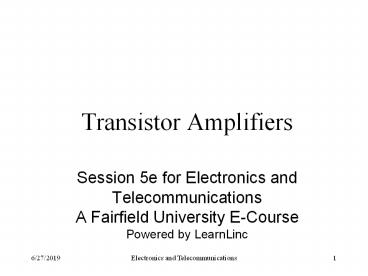Transistor%20Amplifiers PowerPoint PPT Presentation
Title: Transistor%20Amplifiers
1
Transistor Amplifiers
- Session 5e for Electronics and Telecommunications
A Fairfield University E-CoursePowered by
LearnLinc
2
Module Semiconductor Electronics(in two parts)
- Text Electronics, Harry Kybett, Wiley, 1986,
ISBN 0-471-00916-4 - References
- Electronics Tutorial (Thanks to Alex Pounds)
- Electronics Tutorial (Thanks to Mark Sokos)
- Semiconductors, Diodes and Bipolar Transistors
- 5 on-line sessions plus one lab
- FETs, SCRs, Other Devices and Amplifiers
- 5 on-line sessions plus one lab
- Mastery Test part 3 follows this Module
3
Section 5 Semiconductors, Diodes and Bipolar
Transistors
- 0BJECTIVES This section reviews semiconductors,
doping and junctions. The characteristics and
application of Diodes and Bipolar Transistors are
then studied.
4
Section 5 Schedule
Elect 1-7 1.23 1.39 Kybett Chapter 2
Kybett Chapter 11 Kybett pp 51 - 70
Kybett pp 173 - 201
Semiconductors and Doping Well discuss
MT2DiodesDiode Applications Bipolar
Transistors Transistor Amplifiers Review
(Discuss Quiz 4)About 2 weeks to set up the
computers and retrain us
Session 5a 09/18 MT2 Results
09/23 Session 5b 09/25 Session 5c
09/30 Session 5d 10/02 (lab -
10/05, Sat.) Session 5e 10/07 (Quiz 4
due 10/12)Session 5f 10/16(Oct 14 is
a holiday)Break to introduce Learnlinc version
6.1
5
Transistor Review
- Transistors have three leads base, emitter and
collector - Testing via ohm meter
- Two diodes back to back test each separately for
impedance ratio - Check collector to emitter for high impedance
(leakage) - Beta (?) Current gain ? IC/IB , as long as no
saturation (VCE gt 0.2v) - Transistor action
- Carriers injected into depletion region (very
thin base region) - NPN and PNP currents and voltages reversed
- Analyze Base current (IB) flow as a diode
- Collector current IC IB ?
- Collector voltage VC Vbatt - IC RC
6
Todays Topics
- Transistor Biasing
- Setting the Quiesent Point
- Stability
- Amplifier characteristics
- Gain
- Impedances (input and output)
- Amplifier Configurations
- Common Emitter
- Common Collector
- Common Base
7
Transistor Biasing
- Set VB 0.7v desired VE
- R1 R2 form a voltage divider VB VS R2 / (R1
R2) - Determine RE VE / IE ( IE IC IB )
- DC gain is approx. RC / RE
- Input Impedance is approx. ?RE (in parallel
with R1 and R2 so keep them reasonably large)
8
Biasing(continued)
- Vbb 10 v VC 5 vIC 5 mA IE ( IB IC/?
) - Set VE 0.5 v RE 100 ?
- VB 0.5 0.7 0.12v
- R2 / (R! R2) 0.12/10(Use resistors at least
10 times those in the output) R2 2.2 k? R1
16 k?
9
Amplifier characteristics
- Gain (AC and DC can be different)
- Voltage ( Vout / Vin )
- Power ( Pout / Pin )
- Impedance
- Input loads the source reducing the input
- Output A low output impedance makes the output
voltage independent of the load impedance.
10
Common Emitter
- High input impedance
- R1 R2 (Rin?RE) Rin hie 1 k?
- High voltage gain
- ?RC /(Rin?RE) (general case)
- RC / RE (no bypass capacitor)
- ? RC / Rin ( fully bypassed)
- Medium output impedance
11
Common Collector(Emitter Follower)
- The common collector junction transistor
amplifier is commonly called an emitter follower.
The voltage gain of an emitter follower is just a
little less than one since the emitter voltage is
constrained at the diode drop of about 0.7 volts
below the base . Its function is not voltage gain
but current or power gain and impedance matching.
- It's input impedance is much higher than its
output impedance. The low output impedance of the
emitter follower matches a low impedance load and
buffers the signal source from that low impedance.
12
Common Base
- This configuration is sometimes used for high
frequency applications because the base separates
the input and output, minimizing oscillations at
high frequency. It has a high voltage gain,
relatively low input impedance and high output
impedance compared to the common collector.
13
Summary
- Transistor Biasing
- Setting the Quiesent Point
- DC Stability
- Amplifier characteristics
- Gain
- Impedances (input and output)
- Amplifier Configurations
- Common Emitter (voltage gain)
- Common Collector (buffer, low output impedance)
- Common Base (only used in some high frequency
applications)
14
Section 5 Schedule
Elect 1-7 1.23 1.39 Text Chapter 2 Text
Chapter 11 Text pp 51 - 70 Text pp 173
- 201
Semiconductors and Doping Well discuss
MT2DiodesDiode Applications Bipolar
Transistors Transistor Amplifiers Review
(Discuss Quiz 4)About 2 weeks to set up the
computers and retrain us
Session 5a 09/18 MT2 Results
09/23 Session 5b 09/25 Session 5c
09/30 Session 5d 10/02(lab -
10/05, Sat.) Session 5e 10/07(Quiz 4
due 10/12)Session 5f 10/16(the 14th
is a Holiday)Break to introduce Learnlinc
version 6.1

